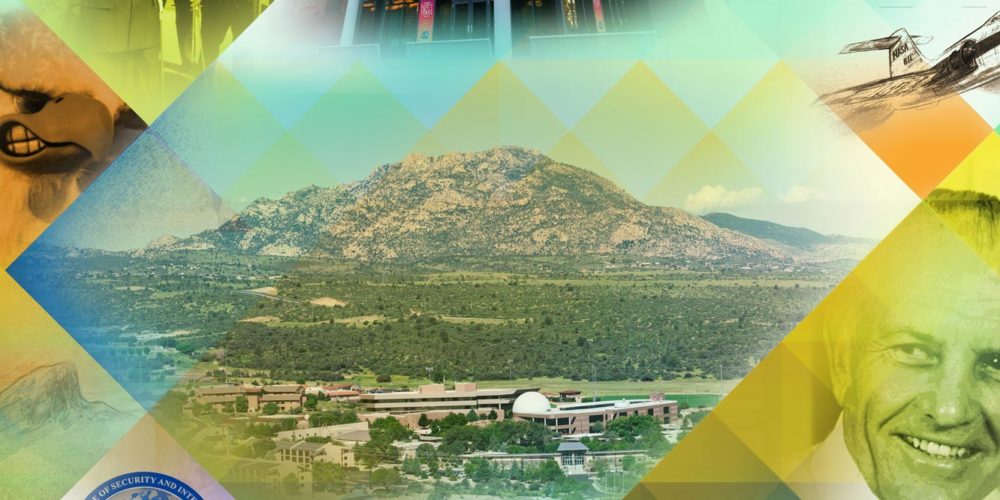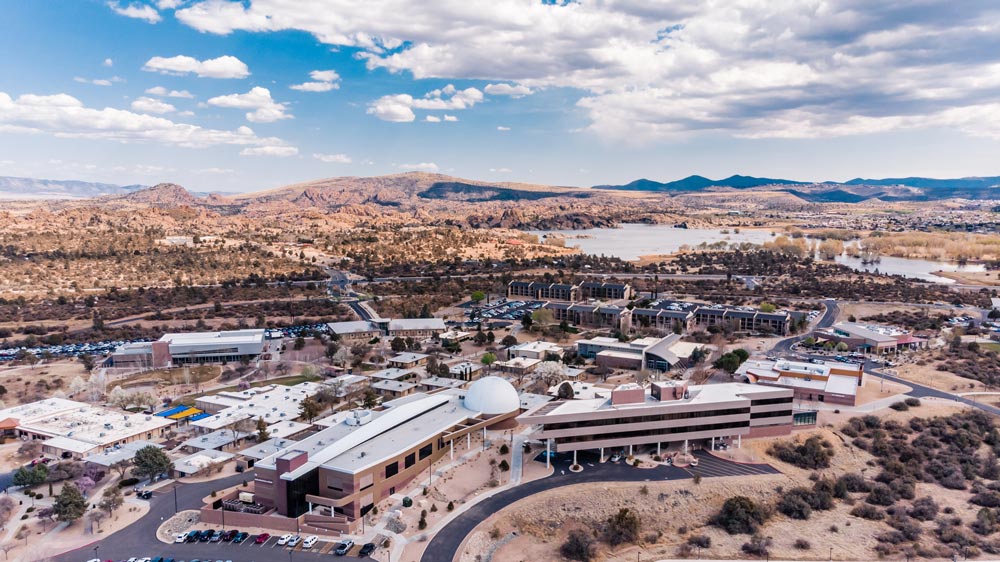Preface
When Embry-Riddle President Jack Hunt visited the former Prescott College property in the late 1970s, his vision to create a western aviation school found a home. In 1978, the university penned a deal to purchase the 500-plus acres located just north of Prescott, Arizona.
Wilbur A. Middleton, the first provost of Embry-Riddle’s Prescott Campus, described the scene in his “Genesis of Prescott College.” Middleton writes:
“Jack sent Hugh Manson, who was a vice president of Embry-Riddle, out to Prescott to reclaim the facility from the desert. In discussions with Hugh, it appeared that a neutron bomb had landed on the campus, disintegrated all the people, but left the grounds and buildings totally intact. [Apparently] just a few days before Christmas in 1975, the Prescott College president told all of its employees and students that the college had gone bankrupt and that he was locking the gates at noon. … In one of the five faculty residences on campus, a pizza was found still in the oven.”
Manson also reported finding Christmas trees still erected in the buildings and dormitories, and coffee cups sitting on desks.
Early Years
Embry-Riddle’s Prescott Campus opened in September 1978 with 240 students and two majors — aeronautical science and aeronautics. The area’s 300-plus sunny days a year were promoted heavily to prospective flight students.
Trustee Emeritus John C. “Jay” Adams (HonDoc ’08) says: “We had so many flight students coming to Daytona that we told them: ‘You can register for aeronautical science, but you won’t be able to fly until January; however, if you go to Prescott, you’ll be able to fly immediately.’ That’s how it really started.”
“It looked like a ghost town,” recalls John Jenkins, who was hired in 1978 as the first Prescott Campus faculty member. “We had all of eight faculty.”
Larry Stephan, now dean of students, came sight unseen in 1979, to be the director of athletics. The “Fitness Center” consisted of one bench and two 25 lb. plastic weights with one bar, and the sports field had not been watered in years, he recalls.
“The first Safety Center we had was made by moving the horses out of the corral and turning the stables into the Center for Aviation Safety Education. We put a couple of wrecked airplane sites in the area that was the corral and started the program,” says Paul Daly, who served as provost from 1981 to 1995.
First off the Bus
“It was a bit like the Wild West,” says Mark Overley (’81), a flight student who arrived in September 1978. “Not much structure; one pay phone; one security person, Andy. The protocol for an emergency was to make your way to the pay phone and call someone. My parents left me here, so they must have been OK with it.”
Sherrie (Graybill) Laurie (’81), who was one of only about 20 female students that first fall semester, says she and the other women all lived in the same dorm and became fast friends. “I absolutely loved it,” she says. “It was so small that you knew all the students and teachers. It was kind of like we were all pioneering together.”
“The first Safety Center we had was made by moving the horses out of the corral and turning the stables into the Center for Aviation Safety Education.”
Laurie became a bit of a celebrity the following year, when her photo was used on the cover of the 1979-80 campus catalog.
Rob Fenton (’82), originally of Long Island, New York, says he experienced some culture shock when he first arrived. But so did the Prescott community.
“Right after the school opened, the local newspaper ran an article with the headline: ‘Small western town invaded by New Jersey,’” Fenton says. The locals weren’t that happy with all the new faces and northeastern accents, he explains.
Taking Flight
Though Dan Carrell would go on to become chancellor in 2000, he first arrived in 1986 as chair of the flight department. Carrell worked to increase support for the Golden Eagles Flight Team, culminating in their first national championship in 1993.
“We were able to come up with a couple of dedicated aircraft for them and also provided opportunity for some of the staff to have time to work with them. It was an opportunity to step up and get some national attention.”
In the mid-1990s the university considered several tough options for the Prescott Campus, including moving it to Phoenix, says Stephen Kahne, who was named chancellor in 1995. The Board of Trustees ultimately voted to keep the campus in Prescott, which was a catalyst that allowed for more investment and improvements to occur, he says.
The Prescott Renaissance
As chancellor, Carrell presided over what became known as the “Prescott Renaissance,” a time of significant growth in facilities and degree programs.
Money was tight, at first, he explains. “[So] we had to be ingenious. We didn’t have a track or field for any kind of sports, so one summer we asked the [Arizona Army] National Guard [258th Engineer Company] to work with us. We paid for the gas to get them up here and they helped with constructing that field.”
“I look at this library as a fountain of knowledge where students can gather to satisfy their curiosity, interact with one another, hatch new ideas and think in a whole new dimension.”
Carrell worked to gain support from then University President George Ebbs and to secure funds from major donors to push the campus to the next level. [See sidebar: Creating Campus Icons.] The first large-scale construction project he oversaw was a new Academic Complex (AC1).
“AC1 just got the ball rolling. It became a centerpiece for us. Over the years we were able to add more facilities, including student services. Now the facilities are beautiful,” Carrell says.
Ron Madler started teaching engineering at Prescott in 1994. Dean of the College of Engineering since 2010, he says that in the early days the students relied on equipment that faculty and staff had built. The Aerospace Experimentation and Fabrication (AXFAB) facility changed that in 2006.
“We designed the AXFAB building around a machine shop and light fabrication suites, and put labs for testing around it. It would build on our reputation for providing a hands-on education … I attribute our steady, sometimes explosive, growth to our AXFAB building and its great labs.”
A Decade of New Growth
Among the campus’s staunchest advocates over the last decade is Frank Ayers (’87). He transitioned from flight training department chair at the Daytona Beach Campus to chancellor at the Prescott Campus in 2009.
“The first thing that stood out was the commitment and dedication of our faculty and staff to the university and each other, and especially to the success of our students,” he says.
Ayers centralized and streamlined the campus budget, held a tight line on expenses and grew enrollments, which allowed for additional facilities and programs.
“We made it a goal to increase diversity, which we’ve done dramatically. Last year we reached 25 percent female enrollments, up from 17 percent in 2009. Along the way, we added 10 degree programs. We’ve grown half again in enrollment, from 1,673 students the day I got here to 2,663, and most of that came in the last five to six years.”
Ayers also changed the campus landscape, adding a host of new buildings. “We opened a new facility every year of the last four years, and it’s all been enrollment-driven. We built a new residence hall because we were busting at the seams, and we’ll open another new residence hall this August.”
Athletics programs have also been a priority. “Joining the Cal-Pac conference was a big moment for us,” Ayers says. “We had four great sports; we added seven more, and there are more coming.”
Under Ayers’ direction, the campus established the nation’s first College of Security and Intelligence in 2014; and it recently created a formal School of Business. In 2017, the STEM Education Center and Jim and Linda Lee Planetarium opened. The Planetarium hosts programs for school children, the general public, as well as the campus. More than 10,000 guests have already passed through its doors.
Beyond the visible changes to the campus, the community perception of Embry-Riddle has come a long way since 1978, Ayers says.
“We have a culture on the campus that I think is pretty unbeatable. Students have an amazing reputation, and the mayors in the area routinely attend the commencement ceremonies. Our graduation rates and retention rates are really, really high, and that’s because of our culture.”
Vision Realized
The success of the Prescott Campus realized University President Jack Hunt’s vision for a robust university system with two residential campuses — one in the East and one in the West — and a truly Worldwide Campus that encompasses the globe. Students can receive the same high-quality education through a variety of means and close to their homes.
The greater Prescott community has adopted the campus and clearly sees it as one of the key strategic pillars to its success. As high-tech businesses begin to come to Northern Arizona, it will increase the opportunities for Embry-Riddle students and graduates, and the campus will continue to grow along with the community.
At the heart of all this is Embry-Riddle’s commitment to the community, its amazing faculty and staff, and its remarkable students. They benefit from a world-class education in a personal and hands-on learning environment, surrounded by faculty and staff who care deeply about their success.
This is the reality of the Prescott Campus today, and into a very bright future.
Contributor: Kevin Montgomery, University Archivist

